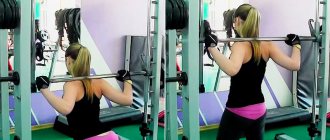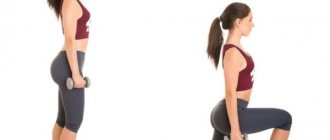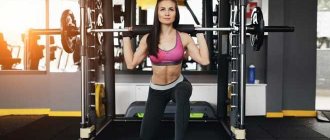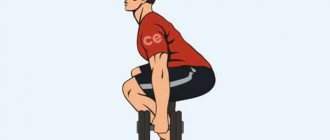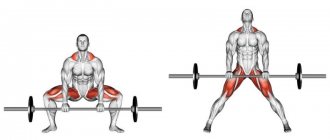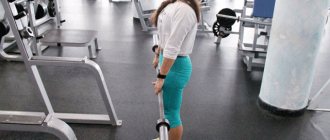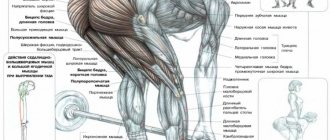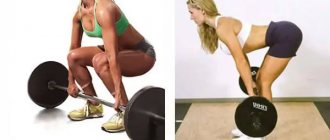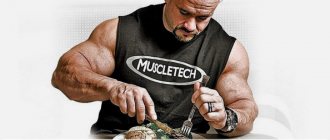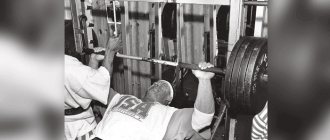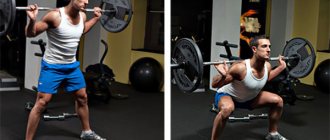Benefits and disadvantages of Bulgarian squats
An obvious advantage of split lunges is that this type of exercise is physically and technically difficult. Firstly, due to the elevation of the auxiliary leg, you need to maintain balance, and secondly, due to the lack of help from additional muscles. In this position, the athlete is deprived of the opportunity to help with the second leg.
This type of lunge uses the maximum number of muscles, compared to other lunge options, due to the position of the second leg, making it impossible to distribute the load.
The disadvantage of the exercise can be considered the technical difficulty of execution. Finding a comfortable position to perform the movement and maintaining balance is extremely difficult, which can lead to falls and injuries.
A person may also experience discomfort in the ligaments. People with ankle or foot injuries may find it impossible to perform this exercise due to severe discomfort or pain in the ligaments.
A few words about lunges and their effectiveness in general
Lunges are a basic exercise and I rank them second only to squats.
That is, I mean in terms of efficiency. Squats are the standard, number 1 in general, there is nothing better than them.
Lunges are the second most effective for the buttocks (in my opinion), and this is really, without exaggeration, one of the most effective and noteworthy: emphasized and simply irreplaceable exercises for the buttocks.
Lunges specifically target the very area that girls/women are so interested in (i.e. the butt)… an exercise from the best of the best that should never be ignored…
In addition to the buttocks, the following are also actively involved:
- quadriceps (front thigh)
- hamstrings (back of thighs)
- back extensors
- rectus abdominis (abs)
What muscles work in Bulgarian split squats?
When performing Bulgarian lunges, the following muscles are involved:
- Quadriceps.
- Gluteal muscles.
- Thigh biceps.
- Adductor muscles.
The stabilizing muscles are the spinal extensors and abdominal muscles.
Features of the exercise
Let's first understand what Bulgarian lunges, also known as split squats, are. They are a more complicated version of classic lunges, where the back leg is placed on a bench or step. Thanks to this technique, the load is concentrated on the muscles of the leg in front. It is convenient to do Bulgarian lunges with dumbbells, but athletes also often use a barbell. For beginners, it’s better to start with exercises without weights at all.
The exercise is recommended for those who already have some experience. Bulgarian lunges, the technique of which seems simple, are in fact far from the simplest exercise. The fact is that you will need to not only do all the work using the muscles of only one, and not two legs, but also maintain balance at the same time.
And although difficulties in implementation, they are justified. This exercise is really effective, and it is believed that it works better than classic lunges and squats. Let's consider its advantages and positive features.
- As we have already said, all the work is done by the muscles of one leg, which stands in front. The only job of the supporting leg is to support the hour and prevent falling. In view of this, the target muscles are worked extremely effectively. You also control the load on your legs, and if necessary, you can work one more intensely than the other.
- The exercise helps to train balance. To make movements and maintain balance at the same time, you need to use a lot of core stabilizer muscles. And the ability to maintain balance is a useful skill that will be useful when performing a number of other exercises.
- Bulgarian lunges help improve flexibility and mobility of joints, particularly the hips.
- At the bottom of the movement, you provide a quality stretch to the gluteal muscles. At the same time, the amplitude of muscle contraction increases, and their training becomes more effective.
- In this case, the load on the spine is reduced, since during movements you do not need to tilt your body, as with classic squats.
Another important advantage of the exercise is that it can be performed not only in the gym, but also at home . The supporting leg can be placed on a sofa or chair. The effectiveness of the training does not decrease at all.
Please note that the main mission of this exercise is to give the legs and buttocks a beautiful relief and ideal shape. To increase the total mass of the legs, classic lunges and squats are more suitable.
Bulgarian lunge technique with dumbbells
- Stand at a short distance with your back from the bench, take dumbbells in your hands.
- Place one leg back on a hill, the knee of the back leg should not be straight.
- The supporting foot should be under the knee. Hands with dumbbells are freely lowered along the sides of the body.
- As you inhale, the pelvis goes down, the knees bend. The knee of the supporting leg should not extend forward beyond the toe.
- Exhale and straighten your supporting leg.
- At the end of the set, remove the foot of the back leg from the hill and change position to the other side.
Execution technique
Before doing the Bulgarian squat, you should carefully study its technique. One wrong move and the risk of injury increases to the maximum.
To protect your ligaments and joints, adhere to the following scheme:
- Stand with your back to the bench. Take one leg back and rest your toe on it.
- Place the other leg slightly forward: 15-20 cm from the body.
- The arms are either straightened along the body or clasped in front of the chest.
- Slowly descend. At the bottom, the thigh of the front leg should be parallel to the floor, and the knee of the back leg should almost touch it. The body must remain straight and maintain an upright position throughout the entire movement.
- Hold the low squat position for a couple of seconds.
- After this, smoothly straighten the knee of your front leg and straighten up.
Not everyone succeeds in such squats the first time due to the fact that they need to somehow maintain balance. However, with regular training, this problem gradually goes away.
Bulgarian lunge technique in Smith
Bulgarian lunges in the Smith machine allow you to focus on one or another muscle group.
- To train the front of the thigh, the foot should be placed strictly under the bar. Moreover, the load will be focused directly on the teardrop-shaped bundle of the quadriceps. The elevation for the auxiliary leg should be installed approximately half a meter from the machine.
- To effectively work the gluteal muscles, the front (working) leg should be placed as far as possible, and the bench closer to the bar. This way the amplitude of movement will be much shorter, the distance between the legs will also be shorter, but this will create a maximum load on the gluteal muscles, they will be in tension all the time. Naturally, when performing this exercise you will not be able to maintain your posture, since you will have to shift your body towards the bar.
Should you perform Bulgarian lunges in Smith in such a way that the knee angle is too sharp and the body is tilted?
Of course, this is not the best option for training legs. There are many more excellent machines and exercises in the gym, thanks to which the athlete will simply achieve results in the development of leg muscles.
Read more about leg exercises in the gym → Leg exercises in the gym for girls →
Recommendations
To quickly achieve benefits from this squat, you need to know a few tricks that experienced athletes and coaches share:
- The Bulgarian split always places an increased load on the knee joint, since all the weight is concentrated on one leg. Therefore, they are contraindicated for people with knee problems.
- Due to the complex technique, they will be difficult to master for those new to the sport. Choose such squats for your training only if you have already managed to pump up well.
- If you pick up a barbell, dumbbells or kettlebells, keep in mind that heavy weights are not used in splits.
- Pay attention to the anatomy of the joints, which plays a very important role in Bulgarian squats. The shin of the working leg must be kept strictly vertical. Point your knee and toe forward and prevent them from turning.
- Don't do Bulgarian lunges just because they're trendy, everyone does them, etc. If the only goal of your workout is to gain muscle mass in your legs, don't waste your time on this exercise. Give preference to the classics.
- The back should be straight all the time. Try not to bend forward, no matter how much you want to.
- Watch your breathing: take a deep breath through your nose and do a squat. Exhale smoothly through your mouth and straighten up.
- Number of sets: no more than 3. Repetitions: 10-12. Training scheme: every other day.
The good thing about Bulgarian squats is that they can be performed in the gym using a multifunctional Smith machine, and at home, where you can take a regular bench or low chair for support. Control from the outside is usually not required, so to effectively perform the exercise it is enough to know the technique and have normal physical training.
Barbell Split Squat Technique
- Take a position in front of a bench with a barbell on your shoulders, with your back to it.
- The height of a bench or other elevation should not be much lower than the knee.
- The supporting leg should be placed on the bench.
- When performing the exercise, the athlete must monitor his posture. The back should be in a vertical position.
- The movement begins with a squat. The back leg is only used to maintain balance.
- The athlete will reach the lowest point of amplitude at the moment when the knee joint forms an angle of ninety degrees. During the downward movement, inhale. The movement is performed slowly and smoothly.
- When moving up, exhale. There is no need to fully extend the knee at the top of the movement.
What is it and what is the difference with regular squats?
You should carefully study the technique of performing Bulgarian split squats, because if you do them incorrectly, you can harm yourself. The main feature and difference between the Bulgarian exercise and all other types is that it is performed on one leg (as well as a pistol), while the second is taken back and placed with the toe on a gymnastic bench or any other low hill.
Thus, the load on the legs increases significantly, and the athlete must constantly control his balance. This is the difficulty, but the effect exceeds all expectations:
- The muscles of the legs are productively worked;
- A person learns to control balance, becomes more dexterous and mobile;
- The exercise develops flexibility of the hip joints;
- Stretches the gluteal muscles;
- The spine is practically not strained;
Girls who dream of slender and sculpted legs, as well as an elastic and round butt, should definitely include Bulgarian split squats with dumbbells in their program.
Common mistakes
Bulgarian lunges are an effective exercise for shaping the shape of your legs. The technique of performing it has its own characteristics, which are associated with the need for careful coordination of movements and maintaining balance during squats.
Having studied the typical mistakes during lunges, you will be able to track them and hone the exercise technique to perfection. So, the main mistakes and ways to eliminate them.
| Errors | How to fix the error? |
| Distortion of posture during squats | Watch your back, keep your posture straight |
| The toe of the supporting leg is turned outward. | Turn the toe of the supporting leg inward |
| Step too short or too long | Calculate the optimal step length, which will prevent you from losing balance during a squat |
| Knee angle too sharp when lunging | When squatting, watch your knee |
| Do not complete squats | Squat until your supporting thigh is parallel to the floor (or lower) |
| Support your knee while coming out of a squat | Don't lock your knee while rising from a squat |
| Lean forward and move your knee forward during the exercise | Watch your knee, do not allow it to go beyond the plane of your toes. |
| Do jerk squats | Do the exercise slowly |
Read also: 5 exercises for losing weight
Initially, you need to develop the correct technique for performing the exercise and learn how to maintain balance while squatting. As you progress, you can begin to complicate the Bulgarian squats by using light weight dumbbells as weights. You can also choose a higher bench to make your squats as deep as possible. The optimal number of repetitions on one leg is 10-12 times. There are 3-4 approaches in a set.
